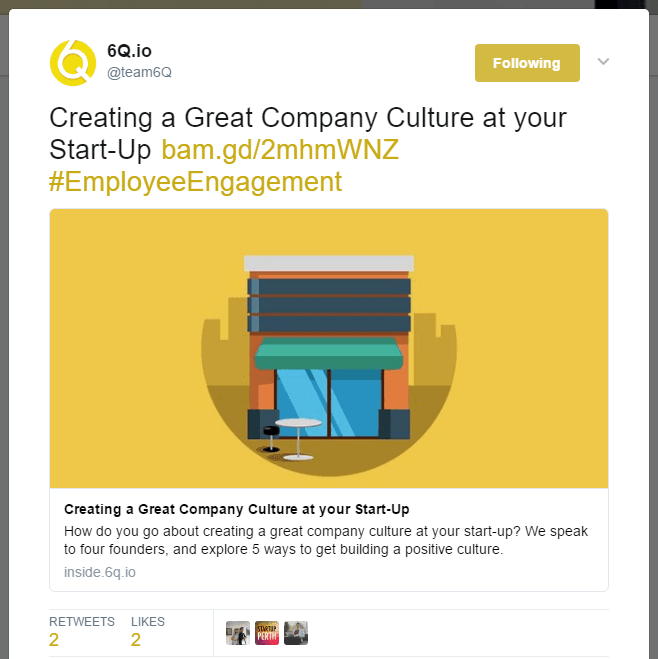As a self funded (bootstrapped) startup, we are very mindful how we spend our marketing dollars. It is the age old question of where to get ‘the best bang for our buck’. In this article, I explain why blogging for startups is such a powerful way to attract customers.
In the last 12 months, 225,381 people visited this very blog, and they read more than 291,000 pages. We increased our email mailing list by thousands (you really should sign up!), had our content shared thousands of times across various social media platforms, and we received lots of great feedback from regular readers.
Importantly though, we were humbled to earn new customers, and help other teams who are yet to be our customers, through the articles we write.
If you ever doubt the value in content marketing, specifically blogging for startups, then read this article. I outline what we’ve achieved and how we do it.
Life as a bootstrapped early stage startup is hard work. We don’t have tens of thousands of dollars for marketing, and we are limited by the time we can spend in various activities.
When it comes to marketing, what we have been focusing on over the last two years, is trying many experiments and determining what works best to attract new customers to our great product, at a fair cost.

Key figures from Google Analytics
Lots of different growth experiments
Since we launched two years ago, we have undertaken plenty of different marketing exercises, mostly as small experiments.
The process that works best for us, is try something out, review what the return is, record the findings and move to other experiments.

We have tried many experiments across a wide variety of channels, such as;
- Google Adwords
- Paid lead generation services
- Bing Advertising
- Facebook advertising
- Interstate trade show exhibits
- LinkedIn advertising
- Influencer outreach
- Twitter advertising
- Face to face networking
- Various landing pages
- Social media outreach
- Email newsletters
The winning formula for us though, is blogging for startups; that means writing articles, right here on this very blog. Sure, it’s hard work at times, however the benefits of receiving great feedback and introducing new customers to our product outweighs the days of writers block, or the occasional groan when we realise we’ve published a spelling error.

Google Analytics graph for our blog
When we experimented with pay per click advertising, we used to spend an average of $3.50 to get someone to visit our website. Using this cost per visitor, we’ve managed to attract $788,833.50 worth of visitors to our articles, for a lot less cost (Oh, how I wish we had $788k to spend on marketing!).
Since we started this blog, we have published 165 articles. In the last 12 months alone that works out to 55 articles. That’s roughly a little more than one new article per week.
We aren’t just churning out anything for the sake of search engines, either; each article goes through a significant process;
- Add suggested topics into our Content Marketing Trello board
- Discuss and shortlist winning topics
- Research topics, looking for scientific facts and what others have written
- Source appropriate imagery
- Style, format and publish on our blog
- Reach out to anyone mentioned in the article
On average, we estimate that each article is around a 5-8 hours work (this was before there were any decent AI content writers on the market. These nowadays significantly speed up the writing process). This works out to roughly 385 hours over the year. I can assure you, as a small business, we aren’t spending even one tenth of the 780 thousand dollars I mention above, for 385 hours work.
We’ve managed to attract $788,833.50 worth of visitors to our articles, for a lot less cost.
– Miles Burke, Founder
Where do our blog readership come from?
So how do readers first hear about our articles? An amazing 86% of first time visitors are coming from search engines. Thanks Google!
Here’s the breakdown, for those numbers geeks.
- 86% came from search engines
- 8% were the result of email newsletters
- 4% from social media
- 2% from everywhere else
So it is an easy presumption that we can drop our efforts on social media and write far less articles, and sit back on our wins, however as any content marketer will tell you, that’s not how things actually work. Let me share some of the lessons we have learnt in our process of blogging for startups, such as ours.
Five key takeaways when blogging for startups
We have learnt a lot of lessons over the last year or two. Here are the big ones we feel are most important for you to know.
- Be smart about topics – don’t just smash your keyboard keys
- Work smarter not harder – create a workflow that works for you
- Be consistent – try and stick to an article a week, or whatever frequency you promise yourself
- Don’t stop at publish – make sure to promote your articles
- Have a goal – ours is taking a free trial, or worse case, newsletter sign up
Let’s dig further into these key takeaways, and explain what it all really means.
Be smart about topics
When we began, we had a long list of topics we wanted to cover. This long list became short quickly, and so we had to start thinking smarter about what topics we should cover. There are only so many ways we can tie employee pulse surveys into an article.
The first job is to understand the audience that is working best for you. For us, it is those who are HR managers at companies with 50-1,000 employees. They may not have that title, however they are in charge of people, and are likely interested in creating great company cultures, and motivating those around them.
Then imagine being one of these people – what would they be interested in reading about? What is topical that can help them do better or more in their role?
A few of the ways we have found great topics, include;
- Look through industry magazines or websites, and find topic ‘gaps’ or ways to change the direction of a topic.
- Find best selling books in your audience market, and look for chapter titles as topic ideas.
- Ask existing customers or readers what they would like to read about.
- Look for questions on question and answer websites like Quora which cover your topic area, and write a blog post as an extension of a really big answer.
Do this over a few hours and you will soon have 100 different topics that may or may not end up being published.
Work smarter not harder
At first, you will be trying out different methods to create, schedule and promote your articles. Once you have a rhythm that works for you, document it, and look constantly for ways to improve it.
Here is our current blogging workflow, as an example;
Whenever one of us have an idea for a topic, we drop it in a card in our Trello board (Topics to consider, as shown below).
Every couple of weeks, we review the list, and move the ones we feel will be best, over to the ‘Topics to do’ list.
We then schedule some time, researching what other keywords around this topic work best, have a look at what articles on the same topic have been shared the most, and then start fleshing out our post structure and dot points.
We use our own post structure, which starts with a bold paragraph in summary at the top, leads the reader through a series of sub headings and action points, and ends with an ‘In Summary’ wrap up. Keeping this consistency means it is easier for existing readers to follow, and really helps us in our writing workflow.
Where possible, we’ll find research on these topics, and look for interesting statistics or facts. If we can find a great quote on the topic by someone well known, we may include this as well.
Once we have finished fleshing it out, we go through with the editing mindset on – we have a style guide of terms, capitalisation, acronyms and the like that we look for, and edit.
Final stage is finding appropriate imagery, checking we’ve styled the article correctly, ensure we add meta data and keywords, and then we schedule the post.

Blogging for startups workflow using Trello
All of this means that the article gets moved from the far left column, step by step until it appears in the right hand column, in the board shown above. Voila! It’s now live.
Be consistent
One of the biggest effects on blog SEO or search engine love, is the frequency in which you post. There’s nothing worse than posting daily for a month, and then going silent for the next six months.
Now that we have helped you with our topic creation plan, and given you an insight into workflow choices, I trust that you don’t have a reason not to keep a frequency up.
If you haven’t yet started posting, I strongly recommend that you write a few posts before starting to publish – this way, as long as you keep one or two up your sleeve, you won’t panic when you run out of posts.
A method we have used before, is to ensure we cover the different categories of content regularly, and date it all. For example, if we were posting every Wednesday, we may put together a document like the following;

Blogging calendar in Google Sheets
This way, we ensure we have one central document, and a process that ensures we post across our categories as often as we can.
You needn’t start immediately with a weekly cadence either; start with maybe every 2-3 weeks, and once you feel comfortable, you can increase the amount of posts per month.
Don’t stop at publish
You’ve poured all this energy into writing a great post, and then you’ll hit publish and forget about it? I hope not!
You need to have a promotion plan for sharing this newly published content to your audience. We have a nice checklist we run through with every new post, to make sure we get the most value from our work.
Our first port of call is scheduling a few posts in Buffer (to manage all social media in one place), using different titles and text, This then posts to our Twitter account, Facebook and LinkedIn page.
Then, we will schedule it for our next monthly email newsletter. When it comes to newsletters, like with cold email subject lines, it’s essential to use proper email subject lines to grab the attention of the receiver.
When we mention people or brands in our articles, we will reach out and let them know about it by email or using Twitter. This often results in them sharing the articles to their audiences, which helps drive our reach further.
Sometimes we reach out and do guest blogging on specific sites, to help drive further interest.
We regularly re-share our older content as well – much of what we write about isn’t time sensitive, and we often get a renewed sense of interest by sharing a few months after publishing. To do this, we have a spreadsheet of our content, with titles, URL’s and hashtags, and rewrite headlines and reschedule. It’s one of the secrets to successful blogging for startups.
Define a clear goal
It is important that you can answer the question ‘Why are you blogging?’. Believe me, there are plenty of people out there who will say ‘Because our competitors do’ – this, my friends, is not a good reason at all.
For a product like ours, our goal is to encourage readers to click on the ‘Free trial’ banners we place in our content (see the black box above, as an example). If we can’t convince you to do that, we do try to get you to subscribe to our mailing list. The first goal is obvious; if we get someone to try our product, we trust they see the value, and will upgrade to a paid plan before the 25 days are up. The second goal, is designed so we can remind you subtly through sending a monthly email full of great advice.
For you, it may simply be click the BUY button, or join a mailing list. Whatever it is, ensure that you track these goals in Google Analytics or your chosen analytics software, and measure what posts are getting what responses. Traffic is great to have, however it is a waste of effort building up a large readership, if nobody is signing up or converting!
Keep an eye on this, and try making changes, to see what you can do to improve the goal conversions – we regularly change the titles and text in the boxes like above, across the entire blog, by using a WordPress plugin aptly called Insert Post Ads.
In Summary
Regularly blogging for startups such as 6Q can make a huge difference to your bottom line. It needn’t cost a fortune, and helps build an ever increasing audience of people who enjoy your writing.
Just ensure you spend time planning topics to cover, have a great workflow that saves you time and is repeatable, be consistently posting great, helpful content and remember to promote these articles. Finally, ensure you have a goal that you measure. Good luck!




